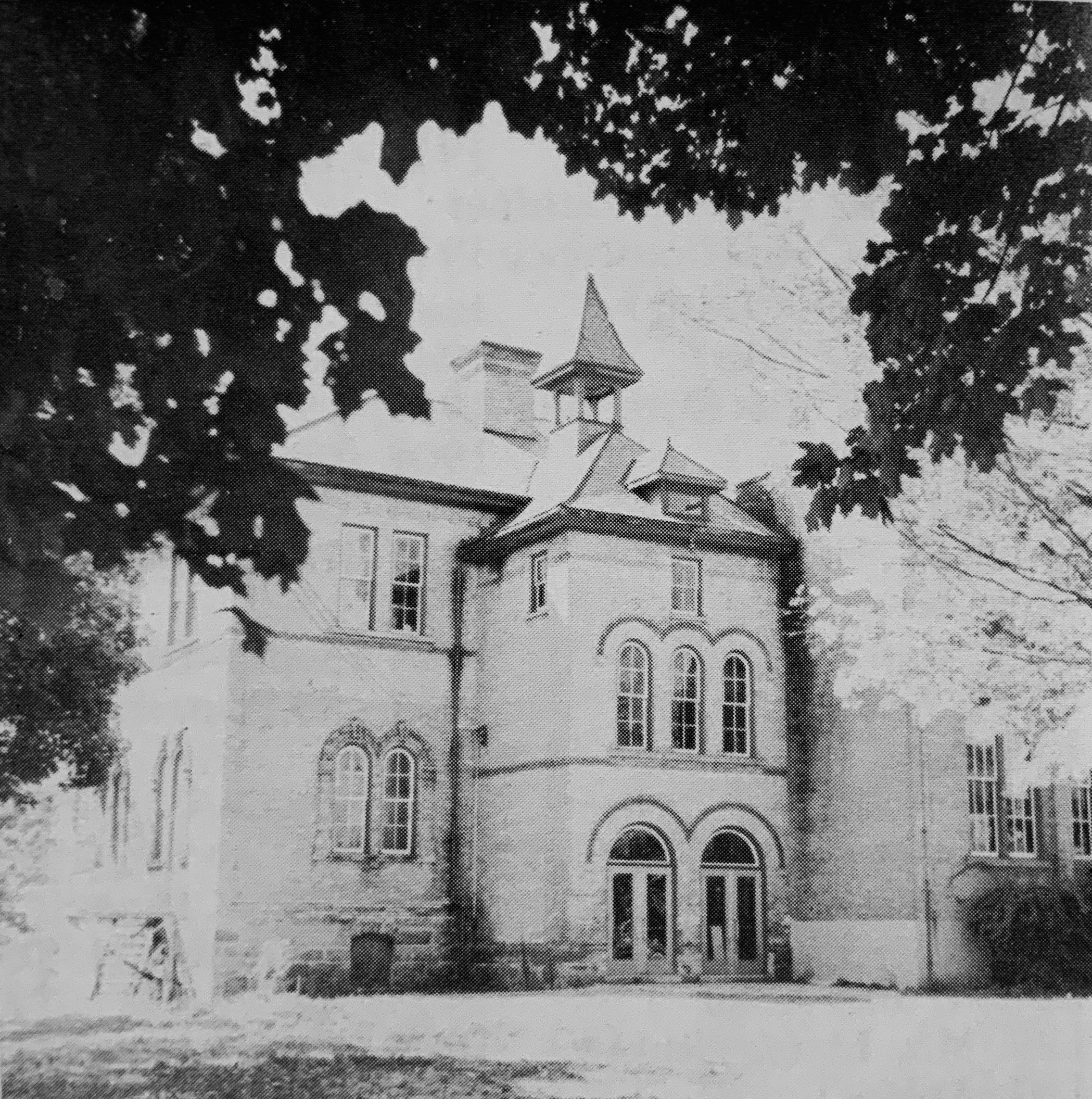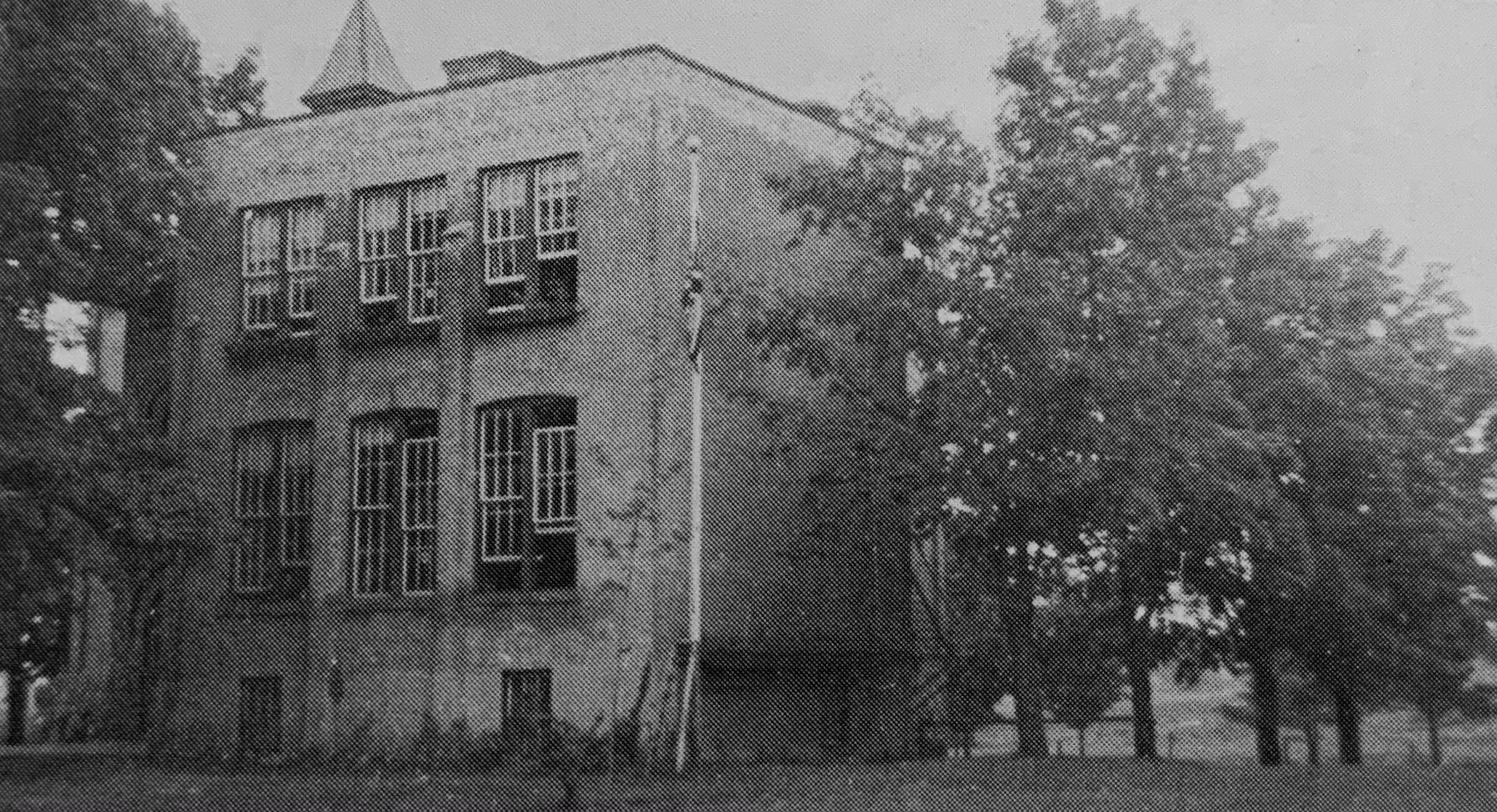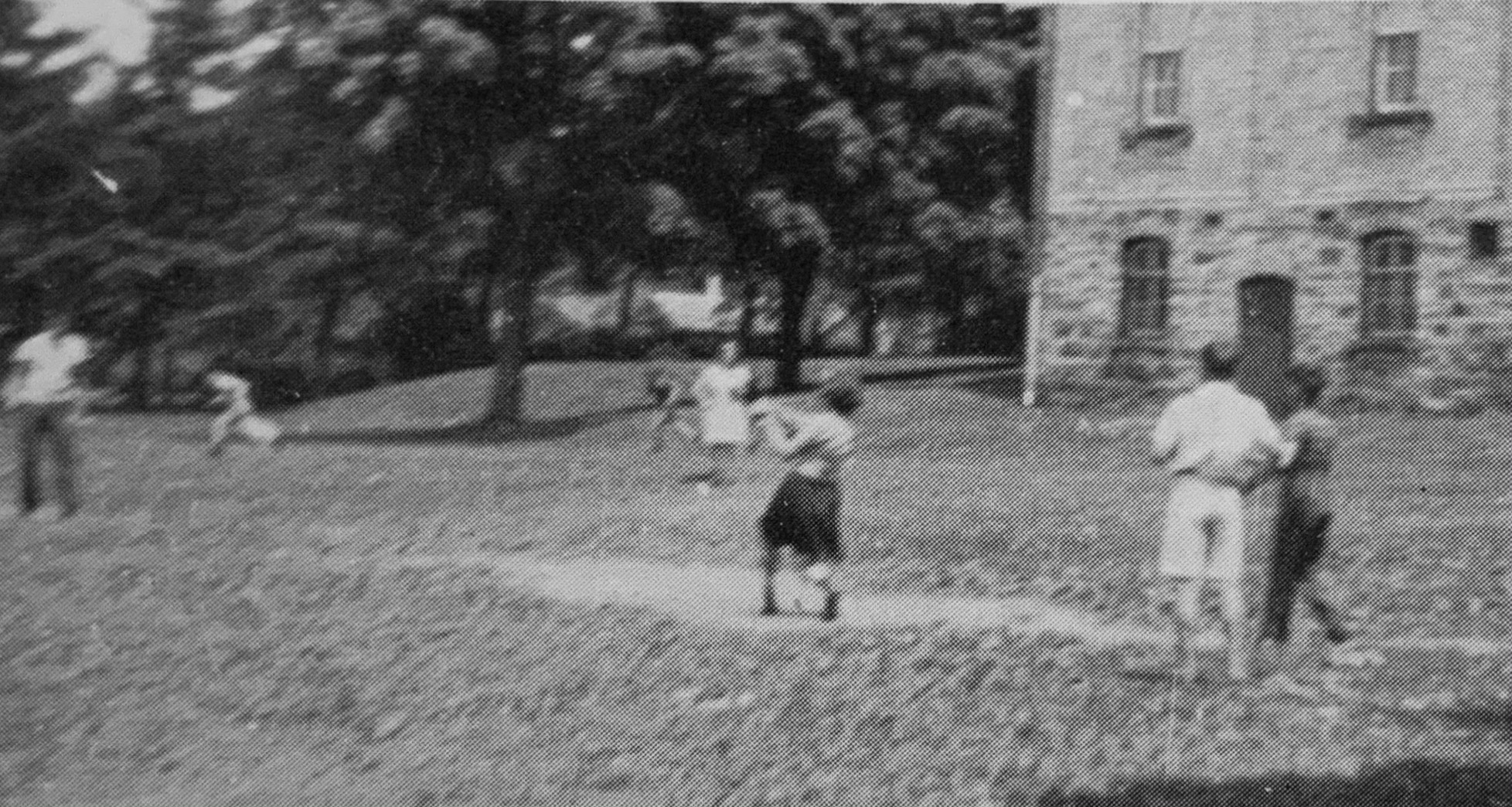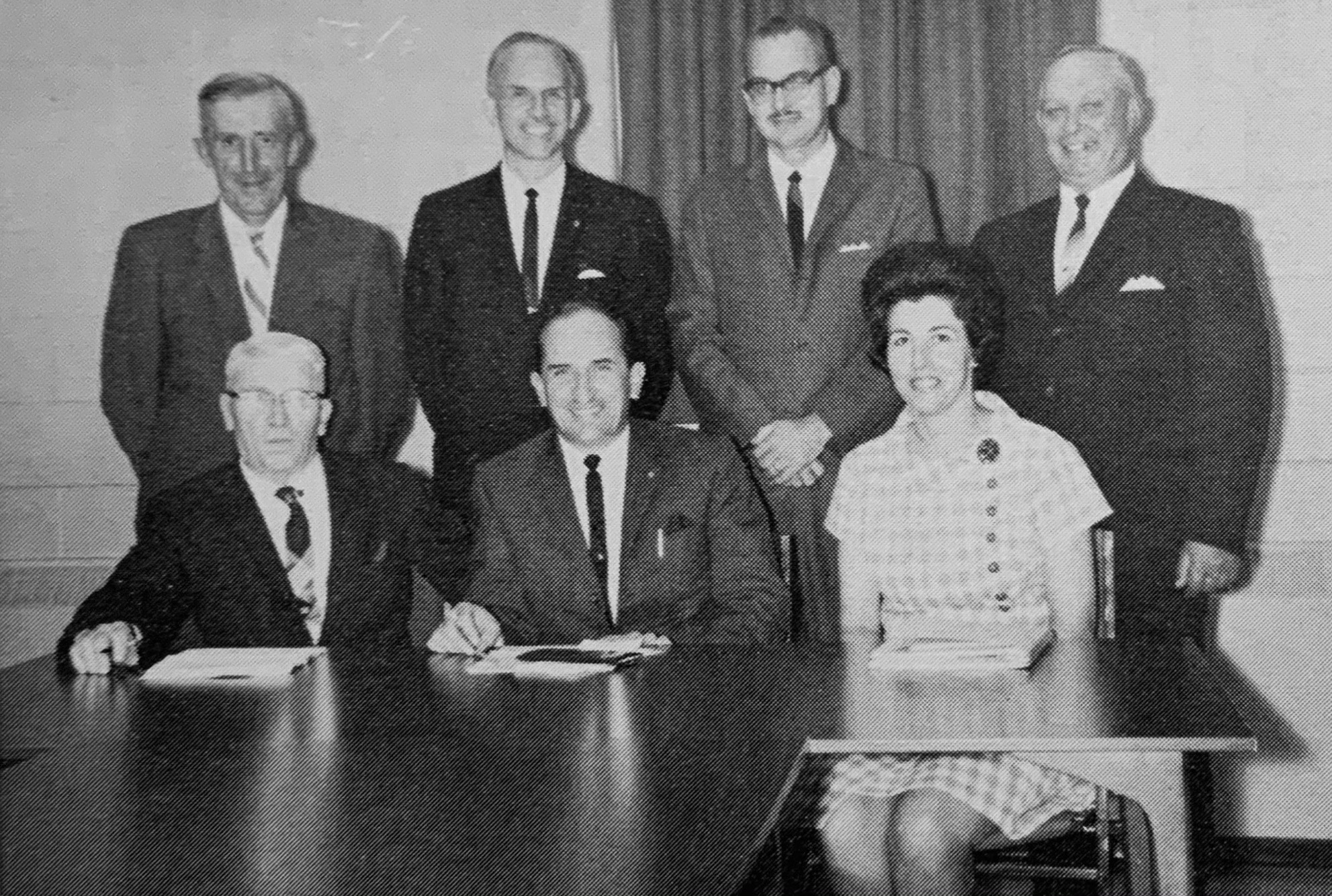| Fact & Fantasy: A History of Tavistock & District | Education - Page 74-75 |
|
|
TAVISTOCK PUBLIC SCHOOL 1910 - continued OCTOBER 14, 1951 -Four bushels to C.N.R. Depot at Woodstock at 7 p.m. for the visit of princess Elizabeth and the Duke of Edinburgh. JANUARY 24, 25, 1952 - Presentation of the Operetta. "Send for Aphais" in Opera Hall. - $160 cleared on the two nights. MAY 19 - 23, 1952 - Mary Mallon on Adventure in Citizenship. May 1955 - Janet Seltzer chosen as Adventurer. (see Rotary Club.) SEPTEMBER 28, 1952 - Bus trip to Museum, The Telegram, The Globe and Mail. FEBRUARY 12, 13, 1953 - TCS & Gr. 7 & 8 presented the operetta, "Ask the Professor." The Tavistock School Bell has tolled for the last time. It rang again and again - the boys were having fun without danger of reprimand. It was 1:30 p.m., July 29, 1967 and the call to order for the bidders and the non-bidders came from Auctioneers Amos Zehr and Wally Ross. The occasion was the sale at public auction of the former school and contents, along with the lot on Highway 59, that had served as school garden, when agriculture formed part of the curriculum. It had been purchased from Mrs. Jos. Duval in the Thirties. The highest bids came for the classroom clocks. Whole rooms of seats could be had for $5. The building and grounds brought only $5000. It marked the end of a glorious era for many. Even though settlement had begun in the village as early as 1848, no local school appeared until 1880. The one in Sebastopol had been built two years before and took care of all pupils to the north of Hope St. Mr. Abraham Bretz, who had been principal of this school, signed on in Tavistock and for some months conducted classes in Loth's Hall, above the shed behind the Commercial Hotel, where some of the churches also had their beginnings. Some of the pupils who attended at that time were:
Georgina Matheson (Mrs. Collom), Katie Seltzer (Mrs. Fred Schliuse), Annie Spark (Mrs. J.G. Field), Charles Hanke, Otto Kalbfeisch, Louis Loth, the Malcolms, Moses Staebler, Horatio (Race) Murray, Andrew Dryden, Harry Russell, Jacob Wagner, Lizzie Wagner (Mrs. J.W. Alles), Conrad Seltzer. Forty-five to one hundred students used this hall for a little over a year. - from notes of J.A. Seltzer The second era began with the construction of a two-room school on William Street. In July 1898 the Tavistock Gazette reports that they are rushing the work on the second storey in order to have it ready for the new term. In 1910 Prin. J.J. Edwards had urged the idea, but it was not until 1916 that two more rooms were added to the north-east corner, with Jacob Seltzer Sr. doing the brick work and H.W. Kalbfleisch the woodwork. Russell's Hall (South Easthope Farmer's Mutual Ins. Co. buildings) had been used for the lowest grade by Miss McTavish from September 1914 until the new wing was completed.  (photo to the right) In their wisdom our school board had set up a Grade C Continuation School, so that their students could obtain at least two years of secondary training without leaving home. With the coming of Miss Lawrence and Miss Kennedy, it became a Grade B school with work up to Junior Matriculation, i.e. Forms I, II & III. This enabled students to qualify for their Entrance Certificate, their Intermediate and their Junior Matriculation, with which they could enter Normal School at Stratford, to qualify for a Public School Teaching Certificate, Second Class. In order to win a First Class Certificate - the courses being available at London Normal - a candidate had to write the Senior Matriculation examination of the Upper School, usually at Stratford District Collegiate. Up to 1932 the Port Dover line provided the means of getting to Stratford. We boarded the "peanut" train, so-called because of its narrow gauge, at 9:08 a.m. For years the Tavistock contingent trudged over Mogk's Hill on the way to the Dover Station just beyond the Cheese Factory. With a book of commutation tickets, which gave us a round-trip for 15¢ in place of the regular 55¢ return fare, collegians and Business College students travelled the Dover line in the morning and caught the 4:30 train home on the Main Line. It was a wonderful experience to turn from "top frog" in your little puddle, of six to ten students in a school of fifty, into just another little "hopper" in a school of 500 and a class of 50 or more. The "birds from Tavistock" as Mr. Sprung termed the, had the frightful blessing of instruction under him and "Cam" Mayberry, the principal, whose stentorian tones used to vie for voice victory in the halls of S.C.I. on St. Andrew's St. For a month or so these two would badger and often humiliate us, by telling us, we knew "no more than a canary on a hot jelly cake." But throughout the years the students from T.C.S. proved themselves to be among the top scholars, and won the respect of all the teachers and fellow-students there. "The third era, which officially begins this evening, is the result of the combined efforts of the Tavistock School Boards of the past ten years. In keeping with modern trends in education the old Union Section of Tavistock and part of East Zorra was enlarged in 1965 to include that part of the township north of the Maplewood Sideroad, giving a Public School population of over 300 students. "To accommodate this number, the architectural firm of Kyles and Kyles was engaged in 1965 to design a suitable school, capable of further expansion as Tavistock grows." from Program of the Official Opening - 1966  The New Addition Some five years earlier when a new school building was suggested, the plebiscite had turned the idea down. Some $14,000 were spent on the old structure to strengthen the floor with a steel I-beam, to provide exits from the underground lavatories and to satisfy fire and safety regulations. When the three rural school areas decided to join the village set-up, for the first while, classes were held in them as usual, but on a graded scheme, pupils of certain grades being kept in a single school, particularly the 17th Line two-room building. But this proved unsatisfactory and the new school, behind the Memorial Hall, was the result. The fate of the Continuation School had been decided in 1955. For some years it had become evident that such schools were on the way out, owing to the scarcity of teachers, who would come to the areas served by them, and the lack of facilities and practical courses. The enrolment of 41 in 1941 had gradually fallen to 33 in 1954 and a change was imperative, in spite of opposition by many to the change. It was a question of which High School District we should join, the new Waterloo-Oxford or the Woodstock. In the former we would be entitled to a member on the Board, in the latter we would be a member of the Suburban Board only, with no real vote in educational matters. So, our Board decided in favour of joining the Waterloo-Oxford District High School, which had absorbed our sister continuation schools at New Hamburg, New Dundee and Plattsville and had built a new school just west of Baden. Our students began to attend in September 1955, but we had no member on the Board until January 1956, at least officially, when Mrs. Gordon L. Ratz began to serve.  Dorothy Bale at Bat In 1967 two busloads of about 100 students were commuting daily the 10-1/2 miles. The school has expanded with additions in 1958, 1962 and again in 1967 when a north wing was added with greenhouse and the shops section. The number of teachers has increased from 12 in 1955 to 58 in 1967, the number of students from 269 to about 1000, and the end is not in sight. Mr. James H. Francis is now our representative on the Board, serving as Vice-chairman.  Members of the last School Board of the Tavistock and East Zorra Union School Section. From left to right: Standing: Wilfred Rosenberg (Vice-chairman), Dr. Bruce Halliday, Robert Gladding, George R. Wilhelm. Seated: E.A. Kalbfleisch (Sec. Treas.), David H. Jutzi (Chairman), Mrs. Forrest (Eleanor) Mosher. On January 1, 1969 a new Education Act comes into force under the Hon. Wm. Davis, Minister of Education in the Robart's Conservative administration, whereby over 1000 school boards are reduced to about 100 on a county-wide basis, with 14 to 20 members, chosen on an assessment rather than on a population basis. The unit of East Zorra, Blandford and Tavistock will likely have two members. Objection by our School Board with support from the neighbouring counties has been to no avail.
|